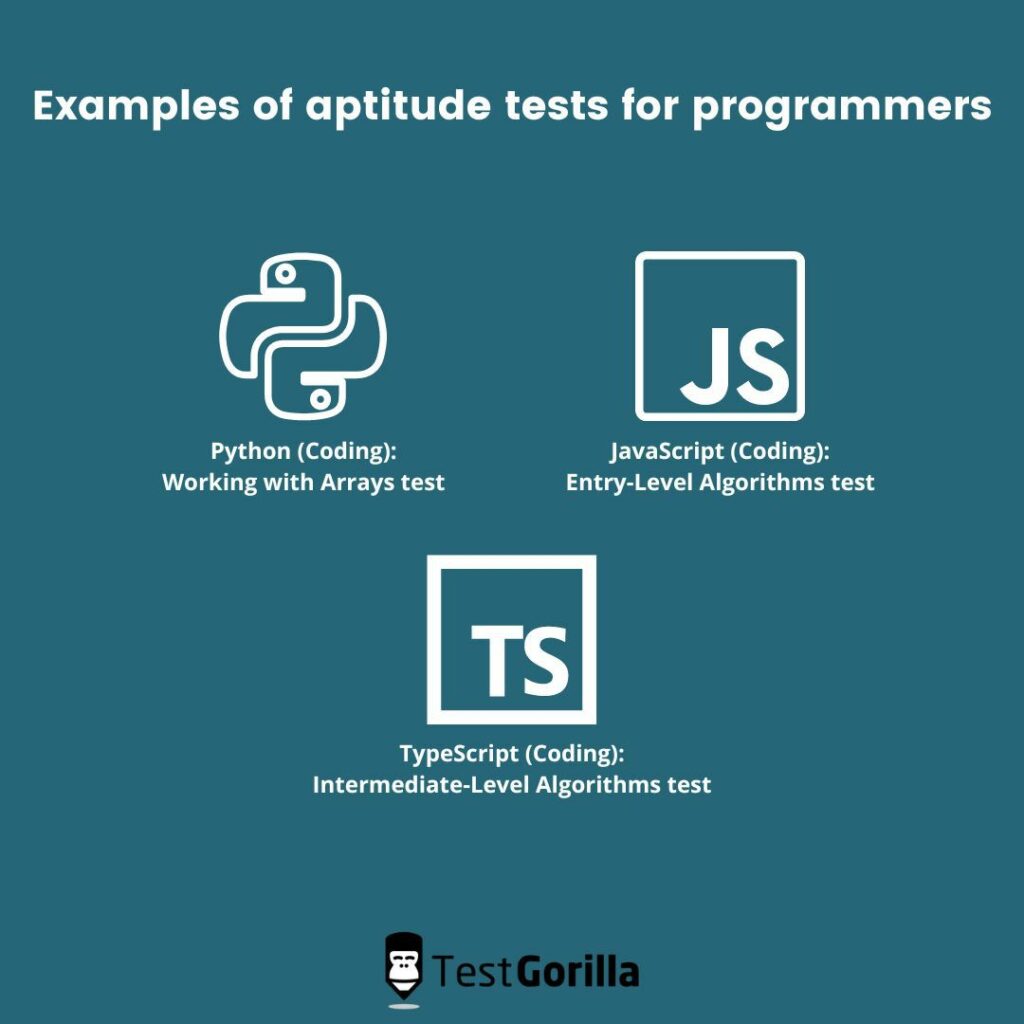Are you hiring a programmer or software developer?
You must determine not only whether your candidates’ abilities suit your open role but also which skills they lack. You need an easy way to review applicants’ technical skills, and time is of the essence if you want to beat your competitors to the best talent.
A coding aptitude test like our C++ skills test may be an excellent tool to help you find the most talented programmers. But why are they important for recruiters, and how can you build a programming aptitude test? Read this article to learn everything you need to know about coding aptitude tests.
Table of contents
- What is an aptitude test for software developers?
- Examples of aptitude tests for programmers
- Why use a coding aptitude test for recruitment?
- 4 key steps to build a programming aptitude test
- How to measure programming aptitude: Two methods to consider
- Coding aptitude tests: a top method for finding exceptional talent
What is an aptitude test for software developers?
A coding aptitude test for developers is a test you can use to review a developer’s coding skills and determine whether they are suited to the job before you invite them to an interview.
Since software developers write code in many different programming languages, such as Python or JavaScript, to create flawless programs and design apps, it makes sense to use coding tests to assess their coding proficiency before hiring them.
If you are a non-technical recruiter, you can use these tests to review how accurately candidates write code, come up with creative solutions to problems, and repair or debug an existing program’s code.
Examples of aptitude tests for programmers
The best examples of aptitude tests for programmers are those we offer at TestGorilla. We have a range of tests that help non-technical recruiters assess programmers quickly, including our:
Python (Coding): Working with Arrays test – for assessing whether your candidates can work with arrays and create an algorithm that includes arrays within a 30-minute time limit
JavaScript (Coding): Entry-Level Algorithms test – for determining whether your applicants can use JavaScript to program an entry-level algorithm within a 10-minute time limit
TypeScript (Coding): Intermediate-Level Algorithms test – for reviewing your candidates’ TypeScript coding skills and finding out whether they can write intermediate-level algorithms within a 30-minute time limit
Why use a coding aptitude test for recruitment?
From assessing applicants objectively and avoiding unconscious bias to reducing your time-to-hire metrics to choosing between two similarly talented programmers, there are many advantages to using coding aptitudes for recruitment.
A candidate’s coding aptitude test results will reveal their best skills and clearly indicate their coding proficiency. You can incorporate this data-driven method into your recruitment process to mitigate unconscious bias.
The method is critical for hiring for tech roles: 91.88% of software developers are male, and recruiters are 6.47% less likely to reach out to women for tech roles even if they have comparable qualifications to men.
If you want to find talent and diversify your development team quickly, coding aptitude tests are the key. They can replace resume screening and save you time since all you need to do is check the test results to select programmers to interview.
4 key steps to build a programming aptitude test
So, what are the main steps to building a programming aptitude test? Consider the four points below to create one with TestGorilla.
1. Consider which skills you want to assess
The first step is to think about the skills you want to assess. Do you want to evaluate your applicants’ JavaScript coding skills or Python algorithm skills? Maybe you want to check their PHP or Kotlin skills? Knowing exactly which abilities you want to assess will help you choose the correct coding aptitude tests. So, check your job description to determine the must-have skills first, like in this Kotlin developer job description, for example .
Our library is full of coding tests. Some are ideal for testing entry-level skills, and others are more suited to evaluating intermediate-level skills. Look through our test library to select tests that align with the coding skill level you are looking for from candidates.
3. Name the assessment and select up to five tests
Next, choose a name for the assessment based on your job title or the skills you want to review.
Once you’ve named the assessment, you can select up to five relevant tests to add to it. From our PHP coding test to our React Native skills test, there is a huge number of coding tests available in our test library.
4. Include custom coding questions in the assessment
With TestGorilla, you can include additional custom coding questions in the assessment. Take advantage of this option to tailor your assessment to review your applicants’ skills exactly as you need.
You can now distribute the coding assessment to your applicants and wait for their results.
How to measure programming aptitude: Two methods to consider
After you’ve shortlisted your candidates based on their test results, measure their programming aptitude by conducting interviews and looking at any side projects they have completed. Let’s consider these methods in more detail.
Conduct interviews with programmers
You can learn more about your candidates’ programming experience using an introductory interview and a technical interview.
Conduct an introductory interview to learn whether your candidates’ soft skills align with your organization and team’s values.
You can also learn about your candidates’ values and communication skills by asking programming skills interview questions such as “Describe your experience working as part of a team” or “How do you resolve disagreements within your team?”
Technical interviews are ideal for assessing whether applicants have the best coding skills for your role. These interviews involve asking candidates to write a code response to a technical question in real time; the applicant will have 45 minutes to solve the challenge.
However, if you are a non-technical recruiter, you can replace the technical interview with a coding aptitude test crafted by TestGorilla’s experts.
Look at candidates’ side projects
Enthusiastic programmers work on side projects to improve their skills outside their current roles. From gaming applications to blogs to portfolio-hosting websites, the side projects your candidates work on will show you their unique skill sets and passion for coding.
Check out your applicants’ side projects to determine whether your applicants aim to keep improving their coding skills.
Coding aptitude tests: a top method for finding exceptional talent
Finding top talent for your business can be challenging, but coding aptitude tests like our Java algorithms test are among the fastest and easiest methods to evaluate a programmer’s skills.Avoid unconscious bias, reduce time-to-hire metrics, and find the most suitable programmer for your company by checking our skills test library for coding aptitude tests and signing up for your free trial of TestGorilla today.
Related posts
Hire the best candidates with TestGorilla
Create pre-employment assessments in minutes to screen candidates, save time, and hire the best talent.
Latest posts
The best advice in pre-employment testing, in your inbox.
No spam. Unsubscribe at any time.

Hire the best. No bias. No stress.
Our screening tests identify the best candidates and make your hiring decisions faster, easier, and bias-free.
Free resources
This checklist covers key features you should look for when choosing a skills testing platform
This resource will help you develop an onboarding checklist for new hires.
How to assess your candidates' attention to detail.
Learn how to get human resources certified through HRCI or SHRM.
Learn how you can improve the level of talent at your company.
Learn how CapitalT reduced hiring bias with online skills assessments.
Learn how to make the resume process more efficient and more effective.
Improve your hiring strategy with these 7 critical recruitment metrics.
Learn how Sukhi decreased time spent reviewing resumes by 83%!
Hire more efficiently with these hacks that 99% of recruiters aren't using.
Make a business case for diversity and inclusion initiatives with this data.






















